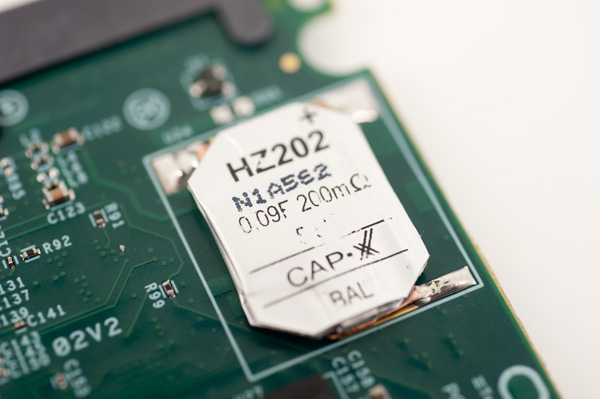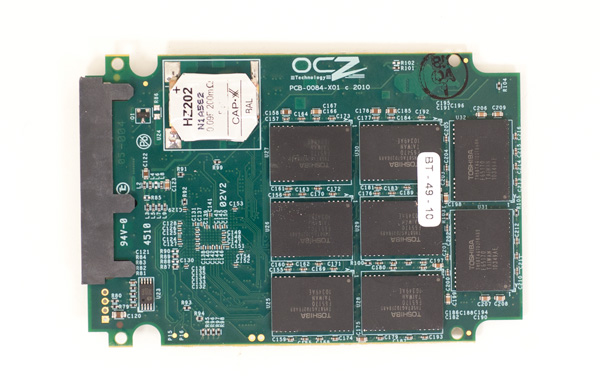OCZ Vertex 3 Pro Preview: The First SF-2500 SSD
by Anand Lal Shimpi on February 17, 2011 3:01 AM ESTToday: Toshiba 32nm Toggle NAND, Tomorrow: IMFT 25nm
The Vertex 3 Pro sample I received is a drive rated at 200GB with 256GB of NAND on-board. The SF-2682 controller is still an 8-channel architecture and OCZ populates all 8 channels with a total of 16 NAND devices. OCZ selected Toshiba 32nm Toggle Mode MLC NAND for these early Vertex 3 Pro samples however final shipping versions might transition to IMFT 25nm. The consumer version (Vertex 3) will use IMFT 25nm for sure.
Each of the 16 NAND devices on board is 16GB in size. Each package is made up of four die (4GB a piece) and two planes per die (2GB per plane). Page sizes have changed. The older 34nm Intel NAND used a 4KB page size and a 1MB block size. For Toshiba's 32nm Toggle NAND pages are now 8KB and block size remains unchanged. The move to 25nm will finally double block size as well.
Remember from our earlier description of SandForce's architecture that its data redundancy requires a single die's worth of capacity. In this case 4GB of the 256GB of NAND is reserved for data parity and the remaining 66GB is used for block replacement (either cleaning or bad block replacement). The 200GB drive has a 186GB formatted capacity in Windows.
This is a drive with an enterprise focus so the 27.2% spare area is not unusual. You can expect the consumer versions to set aside less spare area, likely at little impact to performance.

The 0.09F supercap, a feature of the enterprise level SF-2500 controller. This won't be present on the client Vertex 3.
The Vertex 3 Pro is still at least a month or two away from shipping so pricing could change, but right now OCZ is estimating sales at between $3.75 and $5.25 per GB. The client focused Vertex 3 will be significantly cheaper - I'd estimate somewhere north (but within range) of what you can currently buy Vertex 2 drives for.
| OCZ Vertex 3 Pro Pricing | |||||
| 100GB | 200GB | 400GB | |||
| MSRP | $525.00 | $775.00 | $1350.00 | ||
| Cost per GB | $5.35/GB | $3.875/GB | $3.375/GB | ||
Both the Vertex 3 and Vertex 3 Pro are expected to be available as early as March, however as always I'd be cautious in jumping on a brand new controller with brand new firmware without giving both some time to mature.












144 Comments
View All Comments
PubicTheHare - Thursday, February 17, 2011 - link
Anand,Would this be the drive to pair with a Sandy Bridge Macbook Pro, or do we still need to wait for native TRIM support in OSX?
I'm really eager to buy a Sandy Bridge MBP and do this if the V3P is the one to get. I can't recall which controller you recommended for Macs.
markjx1 - Thursday, February 17, 2011 - link
Why no mention of the fact this was originally slated for the SF-2000, and now its got the enterprise class SF-2500 with disclaimers of "hardware not final" all over the article?The truth is they had major problems with SF-2000 and nobody wants to talk about it - of all people I'd think you would have. Now go ahead and delete my post again.
markjx1 - Thursday, February 17, 2011 - link
Resorting to using the enterprise-class SF-2500 means I worry about cost competitiveness against other upcoming Gen3 offerings from Intel and Crucial/Micron.OCZ took a $25 mil bank loan recently so they need a winner. I worry about the "hardware is not final" disclaimers in the article. Sending these samples out for some buzz smells like buying time while they work out production dilemmas since originally they were going to use a different SF controller.
bplewis24 - Friday, February 18, 2011 - link
Why are you trolling? You have 3 of essentially the same posts on this page. We get it, you think he "sold out" for not mentioning that it's using a different controller.Brandon
vol7ron - Thursday, February 17, 2011 - link
Does this mean a higher QD, might improve performance.It looks like QD of 16 might be the sweet spot in terms of latency vs IOPS
DJMiggy - Thursday, February 17, 2011 - link
Thanks for the great article and thank you OCZ for making my Vertex 1 even more obsolete. That's ok though! Not a complaint! lol Just looking forward to my next upgrade!Rasterman - Thursday, February 17, 2011 - link
Since the drive is 400MB/s read, if you use two in RAID-0 are you going to get 800MB/s or the realistic max of 6gpbs of ~700MB/s?If you use RAID-0 X4 are you going to get 1600MB/s or ~700MB/s?
jwilliams4200 - Thursday, February 17, 2011 - link
With a decent RAID card, then RAID 0 of N drives will give you slightly less than N times the performance of a single drive.For on-motherboard RAID, you will also get approximately N times the performance of a single drive, but there is usually a ceiling to total performance on motherboard RAID. It is around 600 MB/s for ICHR-10.
myterrybear - Thursday, February 17, 2011 - link
I've been a loyal reader of this sight, but what realy myths me if you's use EVERY other controler but those found on the AMD platform .... especialy more so with a Sata 6.0 SSD like this it would match up well for those of us amd users whom have paid money to upgrade the motherboard to have that sb8xx controler onboard to utilize hard drives & other devices that run on the now becoming Sata 6.0 standard.Per Hansson - Thursday, February 17, 2011 - link
Hi, has the much talked about hibernation problem with the Sandforce drives been solved in the 2xxx series?Loosing Hibernation is pretty much a deal killer for me in a laptop :(
http://www.google.se/search?hl=sv&safe=off&...